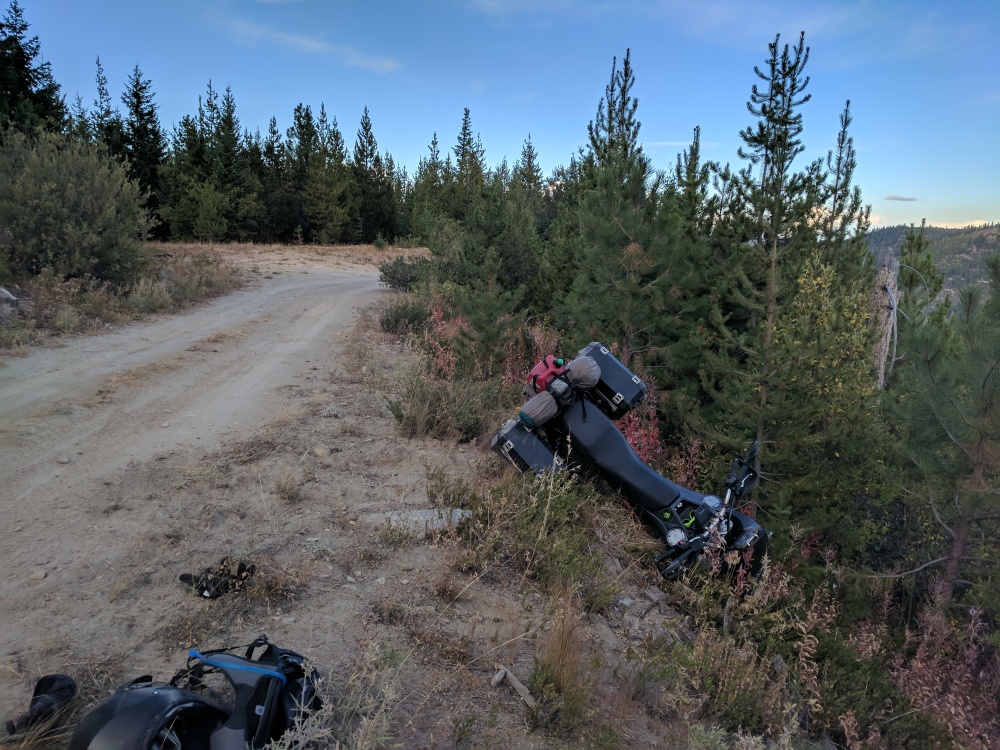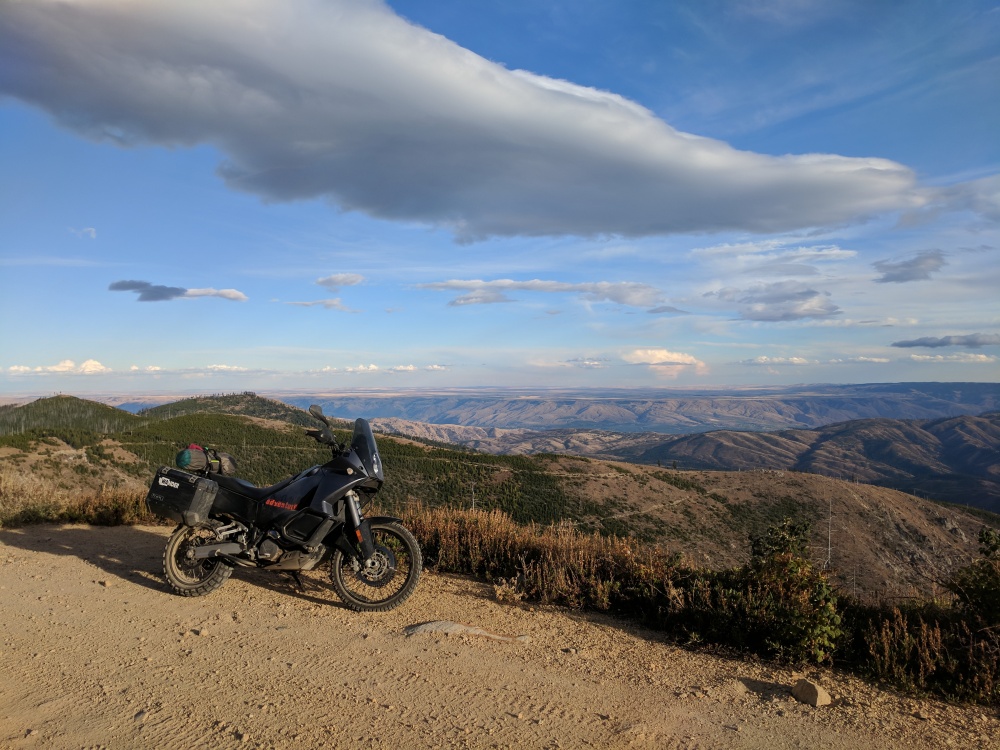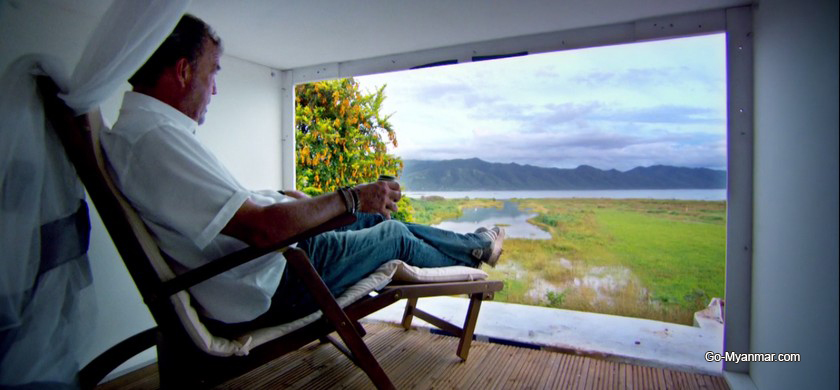For several years now, I’ve been a big fan of broadcasting my mistakes so that other people can avoid making them. It’s a bit humiliating to admit stupid, stupid errors, but it’s important to be honest with yourself and others about where you screwed up in order to learn your lessons as completely as possible. In that spirit, let’s talk about Monday.

I have been slowly (very slowly) working my way through the Washington Backcountry Discovery Route (http://ridebdr.com/WABDR) over the last few years. This summer was supposed to be when I finished the route I began in 2014. For a bit of background, the BDR is a route from Oregon to Canada on ~80% logging roads, jeep trails, and Forest Service roads. It is 575 miles long, split into six distinct sections through the Cascade mountain range. I have completed sections 1-3 over the last few years on my KTM with relatively few problems. This week was supposed to be sections 4-6. It didn’t work out that way.
Section 4 begins in the small Central Washington town of Cashmere. It is a 104 mile long section snaking its way over several mountains and passes. At roughly 40 miles there is a brief period of pavement through the tiny area known as Ardenvoir, on the Entiat river. From there it climbs back up to over 6,000ft to cross Chelan Mountain, down Slide Ridge, ultimately ending just outside of 25 Mile Creek State Park on Lake Chelan. This will be relevant, I promise.
I got started Monday quite a bit later than I had anticipated. As it turns out, going on a brewery crawl the day before a road trip isn’t conducive to timely preparations. Monday morning I woke up at about 6 and began packing, using the BDR packing list to guide my equipment decisions. Once that was done, I made sure that my Delorme InReach Communicator was charged and operational. After these bases were all covered it was time to leave.

$269 plus $30/month. If you spend time in remote areas, it’s a must-have.
I departed Seattle at about 10am, made a quick stop at REI for long underwear and Cliff bars, then headed over Snoqualmie and Blewett passes to Cashmere. I refueled in town, made sure my extra gas can and hydration bladder were topped off, and headed up Nahahum Canyon at 2pm.
I did some quick math in my head as to what speed I needed to average in order to be out of the mountains by sundown, and figured out that the magic number was 20mph. I’m definitely not an offroad riding god, so that was a somewhat lofty goal. Knowing that I would have sufficient fuel to finish the route and that my headlights were both operational, I wasn’t too concerned about being out after dark. It wouldn’t be ideal to descend from the mountains in the dark, but it also wouldn’t be an impossible task, so long as I went slowly once it got dark. My bike-mounted GPS unit was set up to show me both the time-to-sunset as well as a trip odometer, so I was able to keep good track of my progress in relation to the sun for the entirety of the trip.

The view from Nahahum Canyon.
I made it to Ardenvoir right on schedule at about 4pm. The first 40 miles were beautiful, but not terribly technical. I was feeling good as I turned off of the pavement for the next 40 miles of offroad. That was short lived. There was sand everywhere. If you’re not a motorcyclist, or have never ridden offroad, it is important to understand that riding in sand is like trying to run on a treadmill that changes speed and angle every tenth of a second, then sometimes just for funsies moves two feet to the side. You have to be fairly loose on the bike, let it move around a bit, but also ensure that the handlebars don’t just decide to turn hard to the side and buck you off of the bike. In short, sand is my least favorite surface to ride on. Except maybe snow. Maybe.
After doing battle with long stretches of rutted sandy roadway there was eventually a shift to hard pack road with loose sharp rocks. This is a much easier surface to ride on, as you just need to go slowly enough to ride around the sharper, more prominent rocks. This surface continued as I crested Chelan Mountain and began the descent down Slide Ridge.
This is where things go sideways, quite literally. I was riding down the road at roughly 20mph and didn’t see the surface change from hardpack to rutted sand. My bike reacted by kicking the rear tire about two feet to my left, inducing a tankslapper that ended with the bike and I laying on our sides facing downhill.
After a quick self-assessment to make sure nothing was broken and I wasn’t bleeding, I set to trying to find a way of pulling the bike back up to the road. I removed all of the luggage, retrieved my paracord and a couple of luggage straps and began trying to find a way to bring the bike back up the hill. After about 20 minutes of failed efforts I decided to contact my wife via my InReach Communicator and inform her that I would be getting to Chelan later than anticipated due to a mild crash. She was understandably worried, but I assured her that I was fine and that I’d be on my way as soon as I could get the bike back up to the road.
To explain the position the bike was in, it’s important to look at the pictures. It was teetering on a rock that was embedded into the hillside, surrounded on the downhill side by loose bark and branches which were covered/concealed by a bush. The hillside was very steep, with no good footing available. There were also several smallish trees nearby.

It may look manageable, but my right arm has a permanent lifting restriction after tearing my bicep out of my shoulder in 2014. 500lbs of motorcycle is somewhere above that restriction.
I saw that the bike’s weight was mostly resting on the rock, but the rock was digging into the engine case cover. That’s a bad scene, so I decided to stand the bike up and flip it onto its other side in order to protect the engine. I hoped that if I did that, then walked the bike downhill a few feet, that I would be able to angle the motorcycle to roughly parallel the road and slowly work it back up the hill. I would have to cut down a few small trees to make that work, but fortunately I had packed my hand saw per the BDR packing list. Once the bike was in position and the trees were cleared it was getting awfully dark. It had been roughly two hours since the crash, and I was no closer to extracting the bike. My plan to slowly walk it back up the hill was thwarted by pulling a muscle in my lower back, rendering me essentially helpless to do any lifting beyond 20 pounds. A 500lb motorcycle was out of the question.
It was at this point I decided to make camp. I had my tent and sleeping bag, along with some emergency dehydrated food, 3 liters of water, and plenty of battery power for my communicator and phone. I knew it was possibly going to be a long time before anyone went down this particular road, so I messaged Audrea again to ask her to call Chelan County Sheriff’s non-emergency line and inquire about having someone give me a hand getting out of there. Sometimes you have to swallow your pride and accept that things are beyond your capability, and it was abundantly clear that I had reached that point.

If this seems like a lot of risk for no reward, please remember how desperately pretty the route is.
It was at about this time that I realized I had cell service. The area was so remote and rugged that it hadn’t even occurred to me to look at my phone. Fortunately I had two bars, so I immediately called Audrea, who was very clearly upset. Because she’s awesome, she was able to hold it together well enough to have the Sheriff’s Department call me. They were very informative, telling me that their SAR crew began their shift the following morning, but that if my back was too bad they’d send someone out immediately. I assured them that I had enough Ibuprofen to kill a small bear, along with a tent and sleeping bag for the night. The deputy said someone would be calling me the next morning at about 7 and that was that for the night. I finished setting up the tent, poured water into a dehydrated meal pouch, and arranged my tent so that I had easy access to important things (phone, flashlight, headlamp, emergency beacon, etc). I took my sleeping pills, put on another layer of clothing, and climbed into my sleeping bag to watch downloaded episodes of Top Gear while eating my dinner. Soon I was asleep.

I was comfortable, but not “Jeremy Clarkson relaxing in Burma” comfortable.
The next morning I woke up at about 5:30am. It was very cold outside, so I opted to remain in my sleeping bag watching Top Gear until the SAR guy was to call. 7am came and went without a call. At about 8:20 I asked Audrea to call again and check on what was happening. It had snowed overnight, and I was getting nervous about their ability to get to me, let alone my ability to ride down the hill. Five minutes later the county-wide SAR coordinator called me to say he’d be to me in two hours, as he had to drive there from Leavenworth. He asked about the location of the bike and assured me that we could get it out using a come-along and some tow straps.
At about 9:45 I began breaking camp. I wanted to be ready to leave when he arrived in case he wanted to throw my bike in the bed of his truck for the trip down the mountain. Everything went to plan, with the pleasant exception of the deputy arriving about 20 minutes earlier than expected. After pleasantries were exchanged and my enduring gratitude had been expressed we got to work on pulling the bike out. It was at this point that another group of riders arrived. The first two of their group stopped and gave us a much-needed hand in lifting the bike back up to the road. If I run into them again I’ll definitely be buying them a case of beer each.
The deputy was concerned that the KTM would be inoperable, but it fired right up when I pushed the starter button. I thanked him again, gave him my registration for their records, and he was on his way. I finished tearing down my tent, loaded my gear back onto the bike, and since the snow had mostly melted, away I went down the hill for a pleasantly unremarkable trip into Lake Chelan.

She’s a tank.
There were no hotels available in town due to the large number of firefighters battling a wildfire nearby, so I rode to Leavenworth to find a nice hotel room with a jacuzzi tub and a bed softer than the pile of rocks I had slept on the night before. Curiously enough, I passed the SAR deputy going the other direction about a block from my hotel. A sausage dinner, 25 ounces of Mac and Jack’s African Amber, and an hour of soaking later, I went to sleep.
Things I did wrong:
- I was alone. I’ve learned this lesson before, but had apparently forgotten it. One buddy would have been sufficient to get the bike back onto the road within ten minutes and this would have all been avoided. It’s not a mistake I’ll be making again. Partially because Audrea might kill me if I do.
- I left my sleeping pad at home due to space constraints. This led to an uncomfortable sleeping setup and very cold feet the next morning. It’s a small gripe in the grand scheme of things, but it’s important to be thorough in deconstructing these situations. A pad would have preserved my body heat more effectively and would have allowed for better quality sleep.
- I had forgotten my water pot, which led to a cold rehydrated meal instead of a warm one. It’s another small thing, but it would have been good for my morale to have had a hot meal.
- The first part of the Top Gear Burma special had expired (downloaded from Netflix), so I was stuck watching just the second half. Hard life, I know.
Things I did right:
- I had a reliable means of communication. The Delorme unit has paid for itself several times over, and I won’t ever be off-road without it. Audrea was even able to continuously track my movements on a map via the Delorme/Garmin website, giving her much needed peace of mind.
- I had someone who knew my route, how to find me based on that communication device/beacon, and how to coordinate with the Sheriff’s Department. We also had check-in deadlines and rough time estimates for when I should be where in case I was unconscious. Audrea was pretty freaked out, but did exactly the right things. She even had our good friend Nick ready to come get me the next morning if the SAR guys wouldn’t. Thanks Nick! I’m just glad we didn’t have to drag the bike up, because we’re too broken to have done it right.
- I followed the BDR packing list. Even the SAR deputy commented that I was better prepared than most. Years of Boy Scouts beating “Be Prepared” into my head paid off so well that I legitimately was irritated that the first episode of the Burma special was expired. If you’re ever stranded on a snowy mountain by yourself and that’s a thought that passes through your head, you’re doing something right.
- I knew when to admit defeat. At some point dedication becomes dangerous, and at several points in the first two hours post-crash I had to stop myself, take a drink of water or eat a Cliff bar while rethinking my plans. When it was clear my plans weren’t going to work, I knew to swallow my pride and ask for outside help. This was a great decision, because by the time my tent was up and I bedded down, I was fairly loopy and could have made serious mistakes if I hadn’t stopped when I did.
This was a bad situation, but it was a manageable one due to proper preparation, methodical problem solving, and knowing when to swallow my pride. Also a bit of luck that I didn’t get injured in the crash, but that’s what the SOS button on the Delorme unit is for. Next summer, I look forward to dragging some poor soul along with me for sections 5 and 6 of the BDR.
Finally and most importantly, I’d like to extend my deepest gratitude to the SAR coordinator from the Chelan County Sheriff’s Department for coming to get me. You were fantastic, professional, and prompt. You even talked motorcycles with me. Thank you again.

On the must have for big bikes is enough lightweight climbing or sailing tackle to get a 5:1 advantage and a few hundred feet of spectra or dyneema line. All of this weighs only about 4 pounds. This set-up has saved me where I went off the trail twice (both times when I was with another rider, however, even with two of us, there was no way we were pulling a 990 10-15′ up a 45 degree slope), and twice when stuck in mud.
LikeLiked by 1 person
Damn good idea!
LikeLike
Someone on Reddit pointed out that there are bike-mounted winches. I never knew such a thing existed, but now I’m kinda tempted to buy one.
http://www.advdesigns.com/wainxtpomoat.html?gclid=CjwKCAjwxo3OBRBpEiwAS7X62XaJcDptZaIuZyAtj3WxiQXzrYt0mvVkCZigOl4gc7SiLVWHIvcWjhoCddUQAvD_BwE
LikeLike
You could also create something called a flip-flop winch out of trees and rope if space wasn’t too much of an issue: https://www.youtube.com/watch?v=tmGqf_xOYQk
LikeLike
This is my first time reading your blog, and it was very entertaining and informative. As someone who’s keen on starting to get into back country riding, I appreciate your detailed break down of the incident and thorough analysis. I have a background in emergency wilderness medicine so this is very interesting and helpful to read! Glad you made it out okay.
LikeLike
Thanks! I’m glad you enjoyed it. Hopefully you avoid having similar experiences. All I’ll say for the detailed breakdown is that Boy Scouts trained me for years to deal with this type of situation, and that it paid off.
LikeLike
I switched to an Exped Synmat hyperlite MW sleeping pad last year. Very small and light, a little fragile if you’re rough with it (but it comes with repair glue and patches!), and only takes 20-25 breaths to fill it up, and easy to deflate by opening up the valve while you’re lying on it.
http://www.exped.com/switzerland/en/product-category/mats/synmat-hyperlite-mw
LikeLike